ASRock Industrial 4X4 BOX-7735U UCFF PC Review: Zen 3+, RDNA2, and USB4 in a Potent Platform
by Ganesh T S on April 6, 2023 10:30 AM EST- Posted in
- Systems
- AMD
- UCFF
- USB4
- ASRock Industrial
- Rembrandt
- Ryzen 7000 Mobile
System Performance: Miscellaneous Workloads
Standardized benchmarks such as UL's PCMark 10 and BAPCo's SYSmark take a holistic view of the system and process a wide range of workloads to arrive at a single score. Some systems are required to excel at specific tasks - so it is often helpful to see how a computer performs in specific scenarios such as rendering, transcoding, JavaScript execution (web browsing), etc. This section presents focused benchmark numbers for specific application scenarios.
3D Rendering - CINEBENCH R23
We use CINEBENCH R23 for 3D rendering evaluation. R23 provides two benchmark modes - single threaded and multi-threaded. Evaluation of different PC configurations in both supported modes provided us the following results. Similar to one of the PCMark 10 workload components, we see single-threaded performance for the 28W configuration being better than the 42W configuration. However, things return to normal in the mult-threaded case.
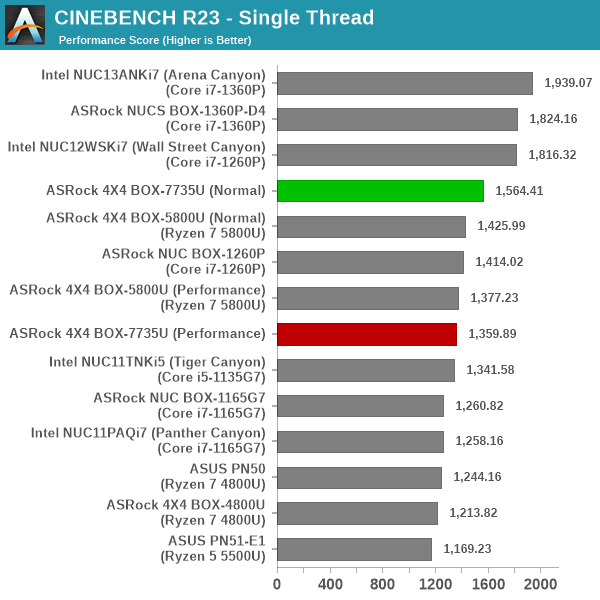
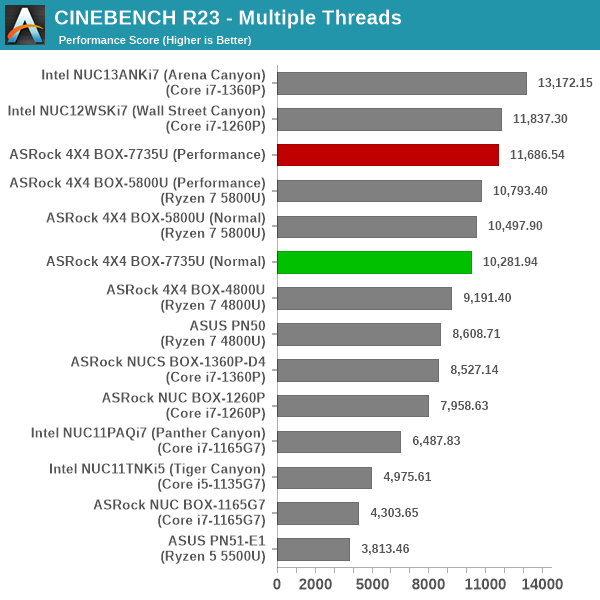
With both ADL-P and RPL-P matching on thread counts (and actually having more, albeit weaker, cores), both ST and MT performance of Rembrandt-R is weak on a comparative basis. However, it is still a solid step up from Cezanne.
Transcoding: Handbrake 1.5.1
Handbrake is one of the most user-friendly open source transcoding front-ends in the market. It allows users to opt for either software-based higher quality processing or hardware-based fast processing in their transcoding jobs. Our new test suite uses the 'Tears of Steel' 4K AVC video as input and transcodes it with a quality setting of 19 to create a 720p AVC stream and a 1080p HEVC stream.
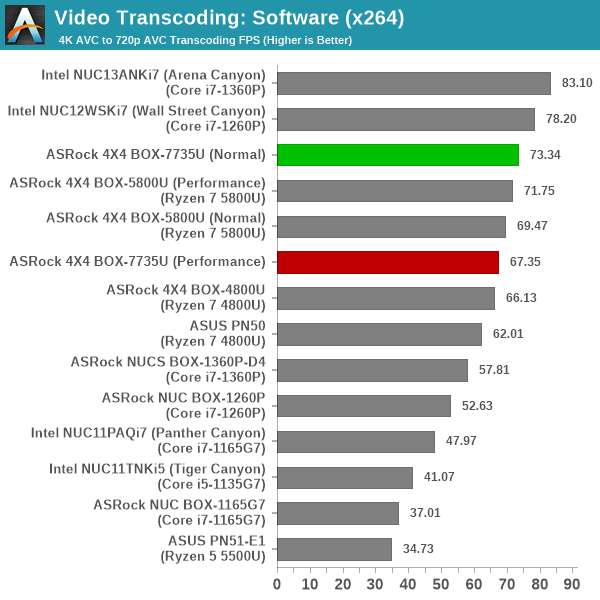
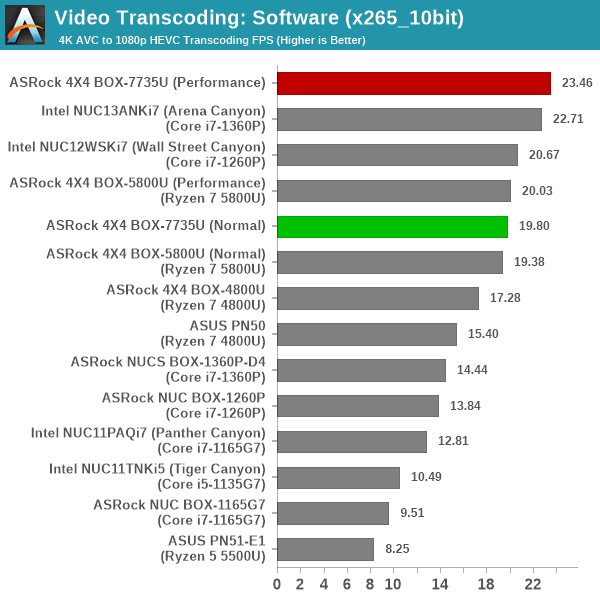
The features used in the x264 workload are more amenable to the heterogeneous processors. However, for x265, we see that a larger number of high-performance cores will outperform the rest when provided similar power envelopes.
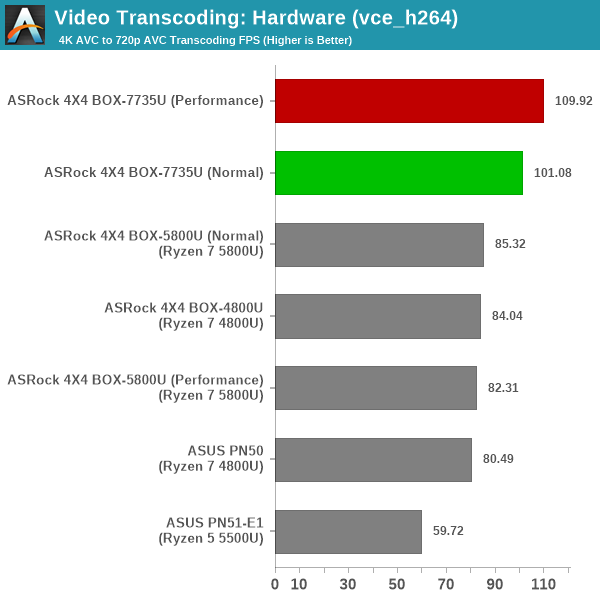
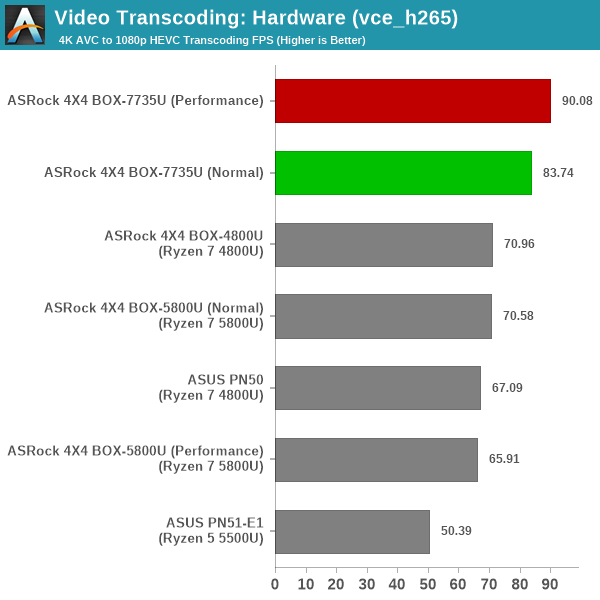
It does not make sense to compare VCE and QSV encoding performance, as the quality of the resultant files are completely different. So, we only look at VCE results here. The VCN engine is clocked at 1.44 GHz - much higher than the previous generation - allowing it to deliver 15%+ performance at similar power envelopes as Cezanne.
Archiving: 7-Zip 21.7
The 7-Zip benchmark is carried over from our previous test suite with an update to the latest version of the open source compression / decompression software.

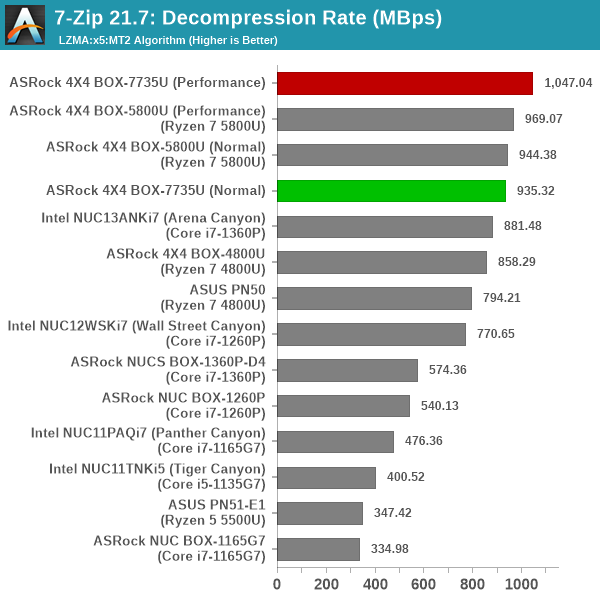
Larger number of high-performance cores helps the Rembrandt-R system gain an edge in the decompression case. However, the competition is much more fierce in the other direction, with both the Arena Canyon NUC and the 4X4 BOX-7735U/D5 delivering similar compression rates at the 40W TDP point.
Web Browsing: JetStream, Speedometer, and Principled Technologies WebXPRT4
Web browser-based workloads have emerged as a major component of the typical home and business PC usage scenarios. For headless systems, many applications based on JavaScript are becoming relevant too. In order to evaluate systems for their JavaScript execution efficiency, we are carrying over the browser-focused benchmarks from the WebKit developers used in our notebook reviews. Hosted at BrowserBench, JetStream 2.0 benchmarks JavaScript and WebAssembly performance, while Speedometer measures web application responsiveness.
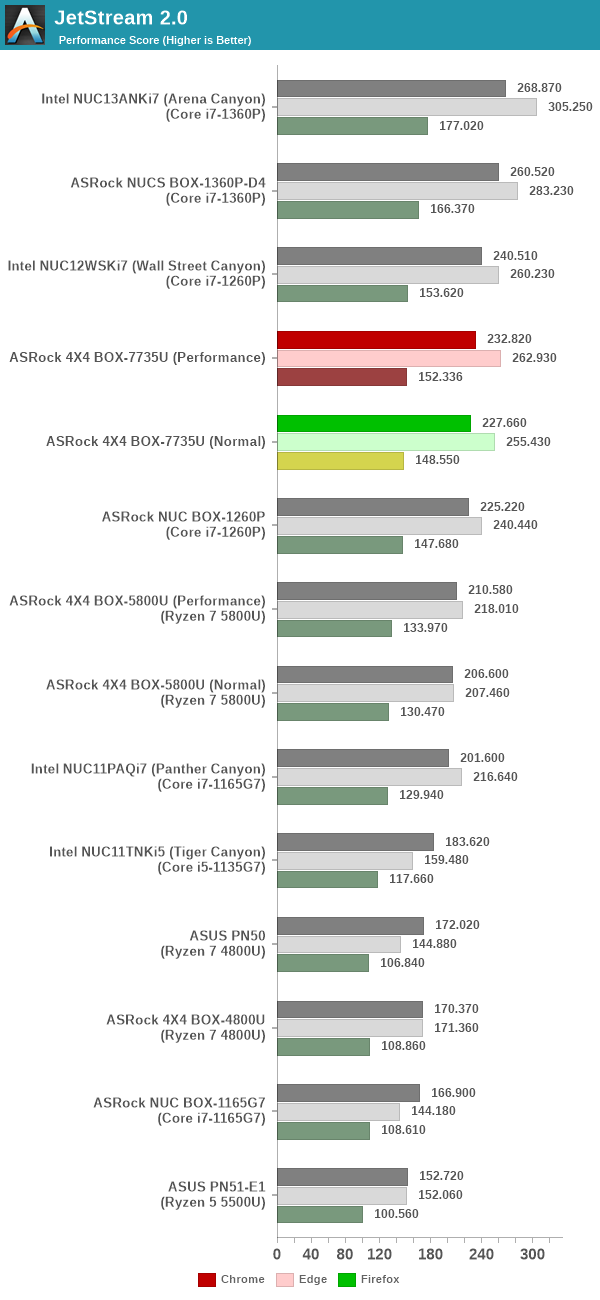
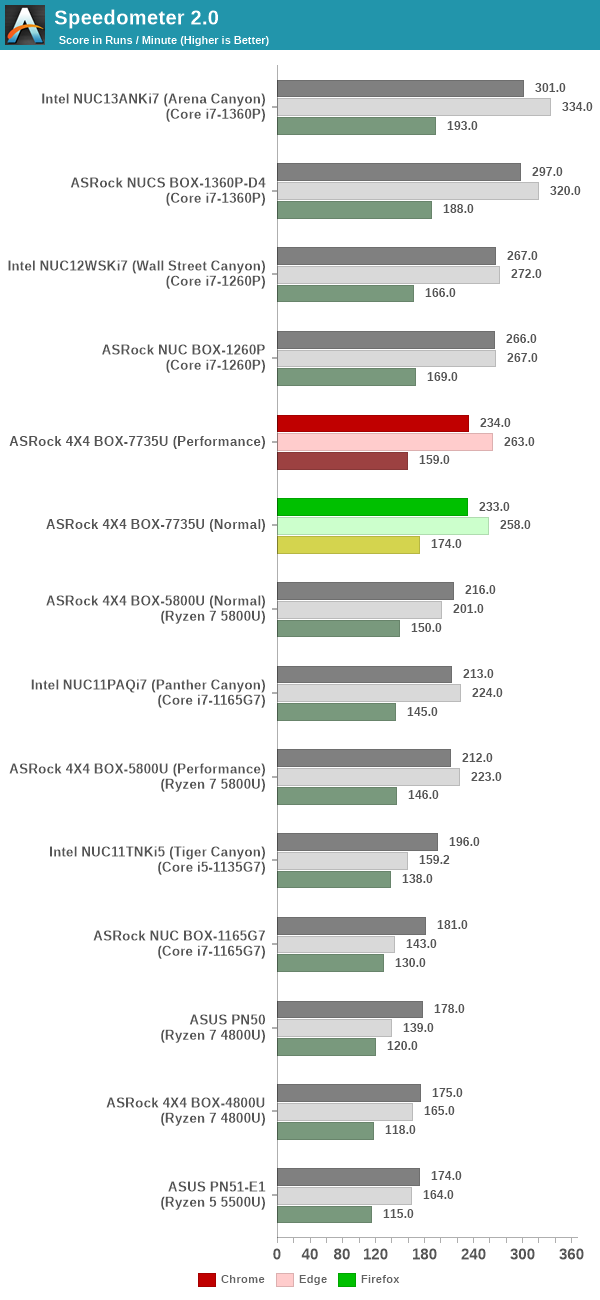
From a real-life workload perspective, we also process WebXPRT4 from Principled Technologies. WebXPRT4 benchmarks the performance of some popular JavaScript libraries that are widely used in websites.
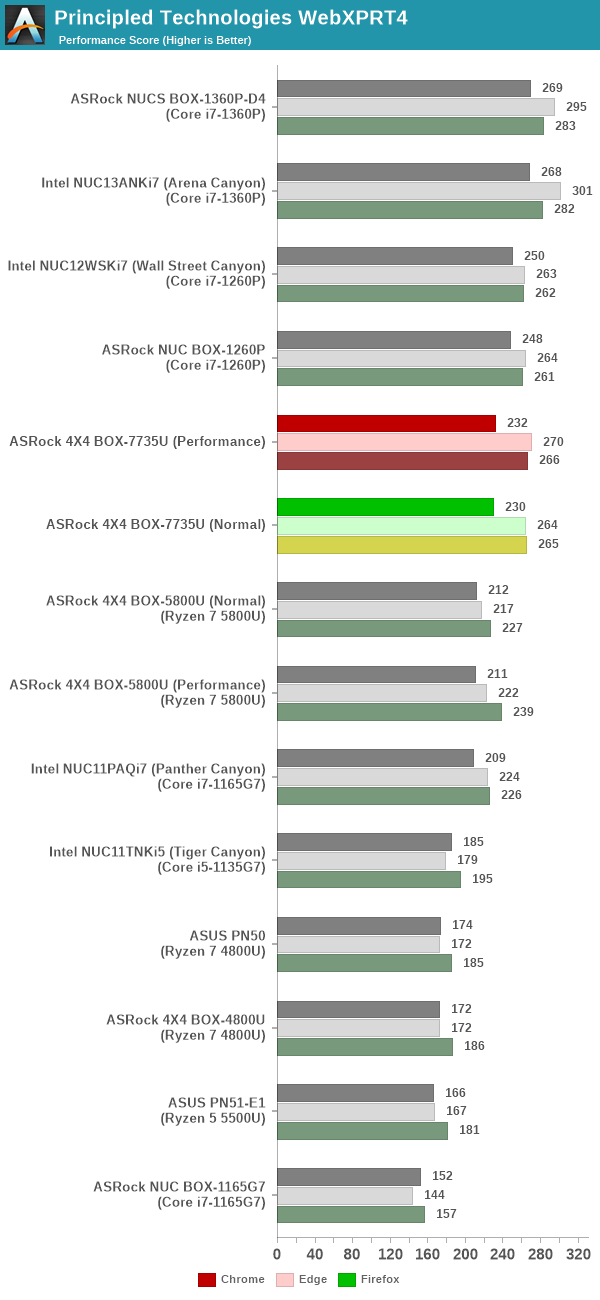
Across all web browsing tests, the systems equipped with heterogeneous processors appear in the top half. However, the Rembrandt-R configurations are right behind them (and would have been on top without ADL-P and RPL-P in the picture).
Application Startup: GIMP 2.10.30
A new addition to our systems test suite is AppTimer - a benchmark that loads up a program and determines how long it takes for it to accept user inputs. We use GIMP 2.10.30 with a 50MB multi-layered xcf file as input. What we test here is the first run as well as the cached run - normally on the first time a user loads the GIMP package from a fresh install, the system has to configure a few dozen files that remain optimized on subsequent opening. For our test we delete those configured optimized files in order to force a fresh load every second time the software is run.
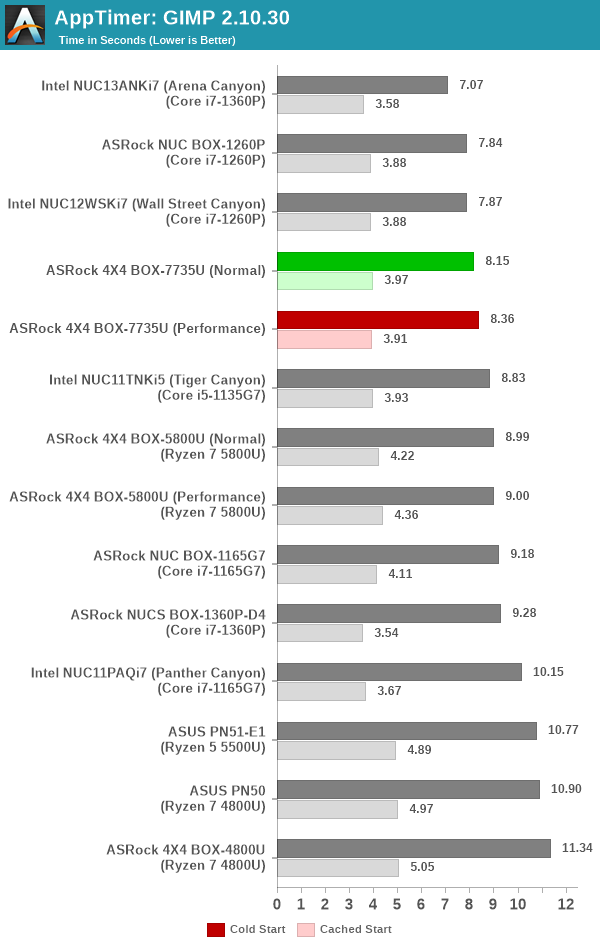
As it turns out, GIMP does optimizations for every CPU thread in the system, which requires that higher thread-count processors take a lot longer to run. So the test runs quick on systems with fewer threads, however fast cores are also needed. The end result is that heterogeneous systems with non-threaded E cores have a slight advantage over the rest of the pack.
Cryptography Benchmarks
Cryptography has become an indispensable part of our interaction with computing systems. Almost all modern systems have some sort of hardware-acceleration for making cryptographic operations faster and more power efficient. In the case of IoT servers, many applications - including web server functionality and VPN - need cryptography acceleration.
BitLocker is a Windows features that encrypts entire disk volumes. While drives that offer encryption capabilities are dealt with using that feature, most legacy systems and external drives have to use the host system implementation. Windows has no direct benchmark for BitLocker. However, we cooked up a BitLocker operation sequence to determine the adeptness of the system at handling BitLocker operations. We start off with a 4.5GB RAM drive in which a 4GB VHD (virtual hard disk) is created. This VHD is then mounted, and BitLocker is enabled on the volume. Once the BitLocker encryption process gets done, BitLocker is disabled. This triggers a decryption process. The times taken to complete the encryption and decryption are recorded. This process is repeated 25 times, and the average of the last 20 iterations is graphed below.
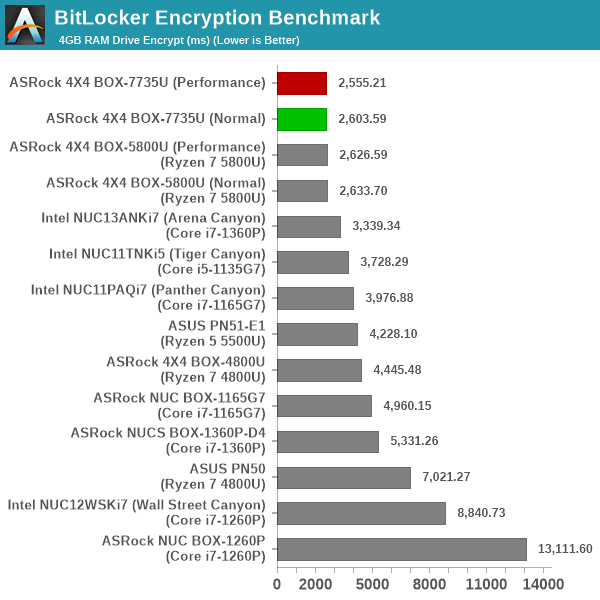
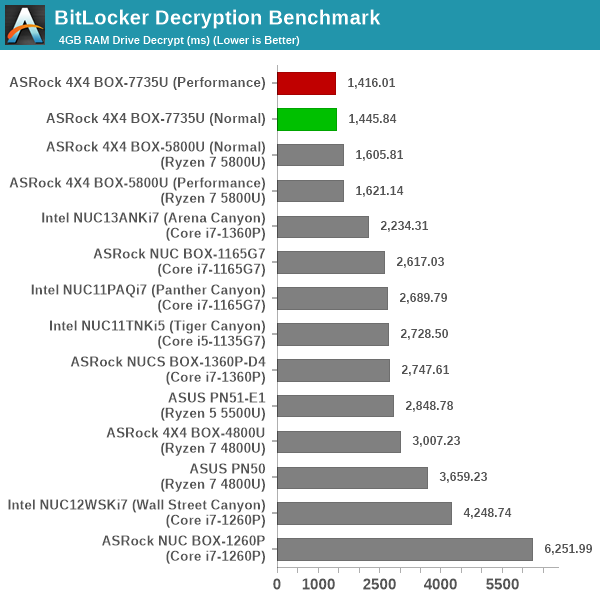
Hardware acceleration is available for the operations in all of the systems. The time taken for processing is directly dependent on the available power budget within each vendor (Intel or AMD). AMD has historically held the edge in these types of workloads, and that continues with Rembrandt-R.










35 Comments
View All Comments
5080 - Thursday, April 6, 2023 - link
Wondering if the 4X4 Box will be updated to the Ryzen 7 7840U or any of the other Phoenix based APU's in the near future.TheinsanegamerN - Thursday, April 6, 2023 - link
Yawn. Another ryzen 6000 rebrandeon product. Nobody cares about that, we want the zen 4+rDNA3 chips.And why oh why do these companies always put the thunderbolt on the front? Most thunderbolt devices are left plugged in, why would I want to dirty my desk with cables wrapped around the front of the PC?
lmcd - Thursday, April 6, 2023 - link
It has all of the IO improvements relevant to this form factor. Zen 4 barely moved the needle compared to Zen 3, and RDNA3's biggest gains were in high-CU yields via chiplets. This form factor doesn't even benefit notably from the expected mild Ryzen 7x4x efficiency improvements.TheinsanegamerN - Monday, April 10, 2023 - link
20%+ increase in perf/watt, only ~5% loss going from 125 to 45 watts, and better clock scaling are "minor". Sure. Dont forget rDNA3, which is supposed to be a 40%+ improvement despite the same CU count.How is that rock you are living under?
lmcd - Wednesday, April 12, 2023 - link
Zen 3 also scales down well, the difference is AMD wasn't advertising it.All of the improvements you listed are desktop 7000 platform vs desktop 5000 platform, and top SKU GPU vs top SKU GPU. Perf/watt improvements mostly came from the die shrink and improved bandwidth -- this platform has a die shrink and improved bandwidth, just the refined 6nm instead of newer 5nm. Clock scaling does not matter at these TDPs. RDNA3 performance literally cannot reach a 40% improvement over iso bandwidth (and there's no way the memory controller got completely reworked in a year's time).
It feels like you eat up hype. Ryzen 7x4x will be nice, but its goal is to be the successor to Ryzen 5000, not Ryzen 6000. Ryzen 6000 is an up-to-date platform that has barely even stretched its legs.
evolucion8 - Tuesday, April 25, 2023 - link
Intel in the other hand cant compete with AMD in the Sub 55W market with Zen 3+, let alone with Zen 4 ROFL.meacupla - Friday, April 7, 2023 - link
No, it's you who doesn't care.As it happens, this is a very fast APU, considering it is a rebranded 6000U series.
Asrock somehow managed to tune the settings so that it is achieving extremely good results in gaming.
As for front or rear ports, does it really matter? NUCs are best mounted on the backs of monitors anyways.
TheinsanegamerN - Monday, April 10, 2023 - link
It achieves the same as any ryzen 6000 chip with DDR5. There's no magic tuning, asrock just stopped gimping.And yes, port placement does matter.
StevoLincolnite - Wednesday, April 12, 2023 - link
No. Port placement doesn't matter on these devices. They are mounted behind monitors.abufrejoval - Sunday, April 16, 2023 - link
I own 5 NUCs, none was ever mounted to a monitor: they connect via a cascade of KVMs to a set of screens that have nothing mounted behind.I bought them for their low idle power and the small space they occupy under my desk. And they share that space with 6 Mini-ITX systems, four workstations and a set of semi-resident notebooks.
While I value that at least their RAM and storage can be explanded, I'd still prefer Mini-ITX mainboards in 5L boxes, because generally they allow me to have or put anything inside (e.g. 10Gbit NICs) that I have to hang e.g. via Thunderbolt to the outside of a NUC.
Unfortunately, getting "NUC power" in a Mini-ITX form factor has become nearly impossible, a very recent Erying G660 (https://wccftech.com/intel-alder-lake-h-laptop-cpu... which I've just added to my collection being one of the very few exceptions.
BTW that board works rather well, at least after upgrading the Pico-PSU to 120 Watts, even if it only consumes 45 Watts on sustained peak loads.
And thanks to a Noctua NH-L9i-17xx cooler it remains unnoticeable even under top load, something which the NUCs only ever achieve when you restrict their PL1/PL2/TAU settings to match their tiny fans.
Just remember that personal computers have been loved for decades, exactly because people could use them in ways that their vendors never imagined.